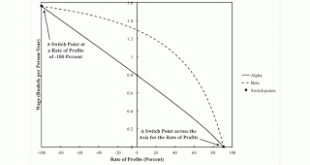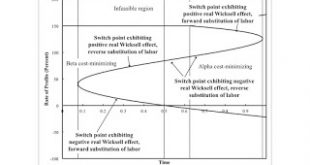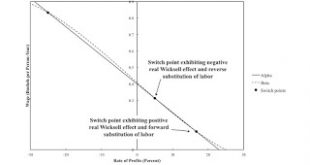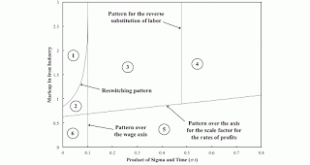Figure 1: Switch Points On The Axis For The Rate Of Profits And At r = -100 Percent This is an example of a fluke case in the analysis of the choice of technique. The interest in flukes, for me, is that they show how the characteristics of markets can change. They provide insight into structural economic dynamics, as Luigi Pasinetti calls it. I have previously shown a fluke case, with a switch point on the axis for the rate of profits with a real Wicksell effect of zero. A perturbation...
Read More »Martin Weitzman’s The Share Economy
I happen to have one book by Marty Weitzman (1942 - 2019) on my bookshelf. So I thought I would write a bit about The Share Economy: Conquering Stagflation. This is an ill-timed book. It proposes that firms negotiate with workers to pay them a percentage of revenues, instead of, say, an hourly money wage. It argues that such a change will address the widespread macroeconomic problem, throughout the 1970s, of simultaneously high unemployment and high inflation. But, by the time the book...
Read More »All Combinations of Real Wicksell Effects, Substitution of Labor
Figure 1: A Pattern Diagram Consider an example of the production of commodities, in which many commodities are produced within capitalist firms. Suppose two techniques are available to produce a given net output. These techniques use the same set of capital goods, albeit in different proportions. They differ in process in use for only one industry. Given the qualification about the same capital goods, generic (non-fluke) switch points are the intersection of the intersection of the wage...
Read More »Positive Real Wicksell Effect, Forward Substitution Of Labor
Figure 1: Wage-Rate of Profits Curves Consider a comparison of comparison of stationary states. Net output is taken as given, and a unit of net output is the numeraire. Technology consists of a finite set of techniques. In each technique, net output is produced from inputs of labor and produced circulating capital goods. No fixed capital is used, and land of the best quality is in such abundance that it is free. Also assume constant returns to scale. One can find a wage-rate of profits...
Read More »Elsewhere
Matthew Klein writes, in Barron's, about "Tarrifs and the Minimum Wage Are More Alike Than You Think". I disagree with some of the stuff in the middle about efficiency and reject the dualistic notion that government intervention is a meaningful concept. But this article otherwise parallels some of my arguments here. Josh Mason has made available his piece in Jacobin about the state of economics after the global financial catastrophe. The Review of Political Economy has made available...
Read More »Extending An Example With Markup Pricing
Figure 1: A Two-Dimensional Pattern Diagram The example in this working paper is of an economy in which two commodities are produced. Technical progress is modeled as decreasing the coefficients of production in one of the processes for producing corn. They decrease at a rate of σ of ten percent. Figure 2 shows how the pattern of switch points vary with technical progress. Initially, the Beta technique is cost-minimizing. Then it becomes a reswitching example. Around the switch point at...
Read More »A Visualization of the Choice of Technique
Figure 1: Regions for Basis Variables 1.0 Introduction I introduced a new way of visualizing the choice of technique for two-commodity models back in 2005. As far as I know, nobody has taken up this idea. I modify my method slightly by having labor advanced; wages are paid out of the surplus at the end of the year. I cite John Roemer in my paper linked previously. 2.0 Technology Table 1 specifies the technology I use for illustration. Each row lists the inputs needed to produce one...
Read More »An Opportunity For The Working Class With Increased Markups
A Switch-Point Perturbation Diagram I have a new working paper at SSRN. Abstract: This article presents an analysis based on a comparison of stationary states. With technology and relative markups among industries taken as exogenous, the long-period trade-off between wages and rates of profits is determined. A long-period change in relative markups among industries can create a switch point exhibiting capital-reversing. Around such a switch point, a higher wage is associated with firms...
Read More »How Monopsonies Work, Now With More Numbers…
[unable to retrieve full-text content]How Monopsonies Work, Now With More Numbers…: Apparently a graph is worth…*checks post stats* 1176 words, but I’m guessing this makes more sense to most normal people.
Read More »How Monopsonies Work, Now With More Numbers…
[unable to retrieve full-text content]How Monopsonies Work, Now With More Numbers…: Apparently a graph is worth…*checks post stats* 1176 words, but I’m guessing this makes more sense to most normal people.
Read More » Heterodox
Heterodox






